 |
 |
 |
| |
Hepatitis C Re-infection Among HIV+ MSM in London & Prisoners in Spain
|
| |
| |
Reported by Jules Levin
".....since the early 2000s we have also witnessed the emergence of an epidemic of sexually transmitted HCV among men who have sex with men associated with high-risk sexual practices, recreational drug use and ulcerating anal lesions.......Using pooled cohort data and meta-analyses it is estimated that the primary infection incidence is in the range of 0.6-2/100py. Now, reinfection with HCV is possible and has been demonstrated among MSM. One study in Amsterdam reported HCV reinfection rates following treatment for HCV as high as 15.2/100py. The reinfection incidence elsewhere is unknown and globally"
Hepatitis C virus reinfection among prisoners with sustained virological response after treatment for chronic hepatitis C - (07/16/13)
HCV reinfection incidence and treatment outcome among HIV-positive MSM in London - (06/17/13)
AIDS 2013 June 3 (oral presentation of study at IAS)
"Our results demonstrate a high risk of HCV reinfection among HIV-positive MSM who are either treated for or who spontaneously clear their initial HCV infection. As many as 25% of individuals treated for HCV will become reinfected within 2 years. These results emphasize the need for effective sexual education for HIV-positive MSM presenting with primary HCV infection and the implementation of preventative interventions to reduce the risk of reinfection. Given their high risk, we recommend enhanced surveillance of previously infected individuals to enable the early detection and treatment of any reinfections. New UK guidelines have been updated to reflect this by recommending HCV PCR testing every 3-6 months among individuals who remain at risk following incident infection clearance [30]."
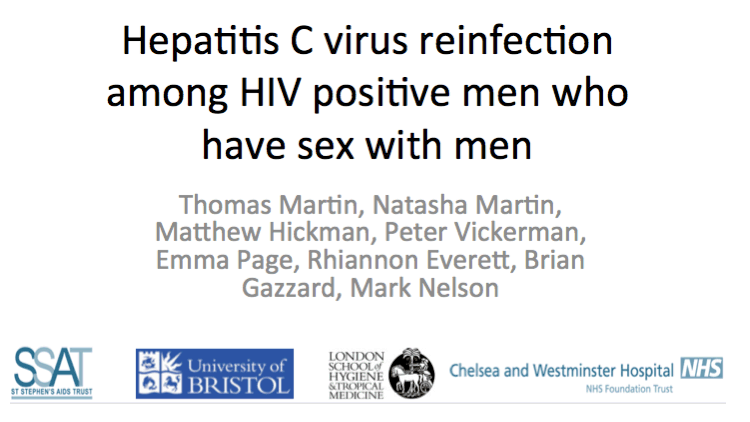
In summary, we found high rates of HCV reinfection among HIV positive MSM in London of 7.8/100py. Following treatment for HCV, our reinfection rate was 9.6/100py, comparable to the 15.2/100py found by the Amsterdam group with overlapping confidence intervals. The higher reinfection rate in the Amsterdam study may in part be explained by the shorter testing intervals during follow up in their study or the use of phylogenetic analyses to demonstrate reinfection allowing the inclusion of individuals who had reinfection with the same genotype of HCV but within the 24 weeks required for SVR.
We found only weak evidence to suggest protective immunity following spontaneous clearance. Indeed, individuals who do spontaneously clear remain at high risk of reinfection.
Lastly, reinfection spontaneous clearance rates and treatment success rates were consistent with those found for primary HCV infection among HIV infected individuals.
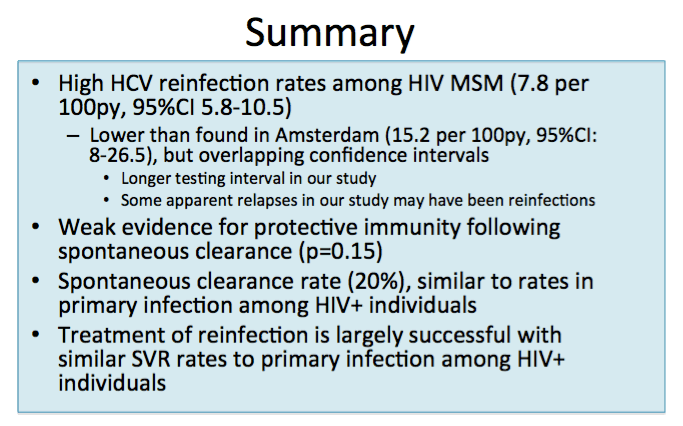
As a result of these findings, we recommend targeted sexual education for HIV+ individuals infected with HCV. We also recommend the enhanced surveillance of individuals who have cleared the virus either through treatment or spontaneous clearance to allow rapid identification and treatment - beneficial both for the individual and for potential onward transmission. UK guidelines have recently been updated to reflect this with HCV PCR testing every 3-6 months who remain at risk of reinfection.
Finally, reinfection spontaneous clearance rates were similar to those found in primary HCV infection in HIV positive individuals supporting a similar approach to management with an initial watch and wait approach to exclude spontaneous clearance before proceeding to treatment.
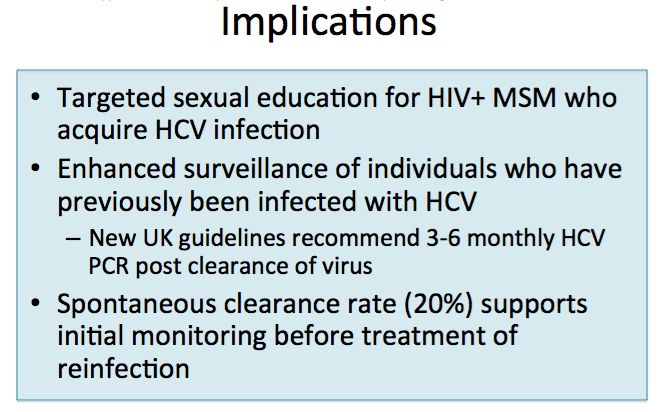
Limitations of our study included its retrospective nature and the lack of phylogenetic analyses to prove reinfection - indeed had we used phylogenetic analyses our reinfection rate may well have been higher reclassifying some cases we assumed to be relapses to be in fact true reinfections. We had variable testing intervals during follow up which may have affected our results in particular the lower reinfection incidence found following spontaneous clearance of the incident infection. Finally, it has recently been demonstrated that in some cases, re-emergence of viraemia within the 24 weeks required for SVR may actually be a non-dominant strain of HCV emerging following eradication of the dominant virus. While this may be the case it would be unlikely to substantially alter our results as we included only 4 reinfections within this 24 week period. Additionally, we believe the vast majority are true reinfections in our study supported by the long duration between clearance of the first virus and reinfection and the high treatment success rate of the reinfections.
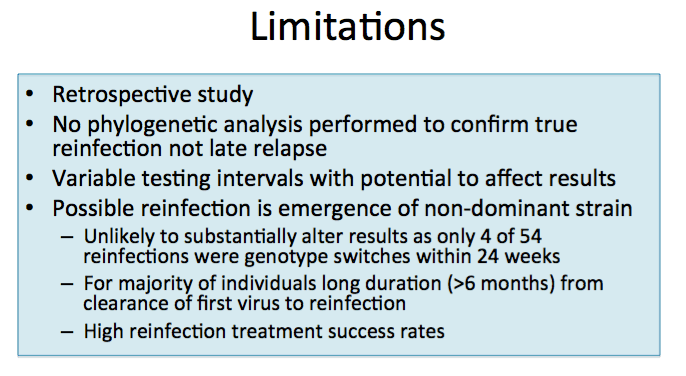
Firstly a brief background to our study. As you will be aware, liver disease has become the leading non-AIDS cause of death among HIV positive individuals. Of these, HCV accounts for the majority. Coinfection with HIV has a negative impact on HCV infection leading to reduced spontaneous clearance rates, faster progression to cirrhosis and reduced treatment success.
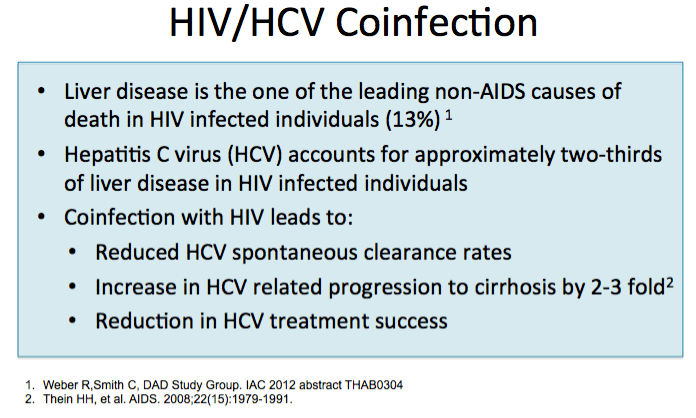
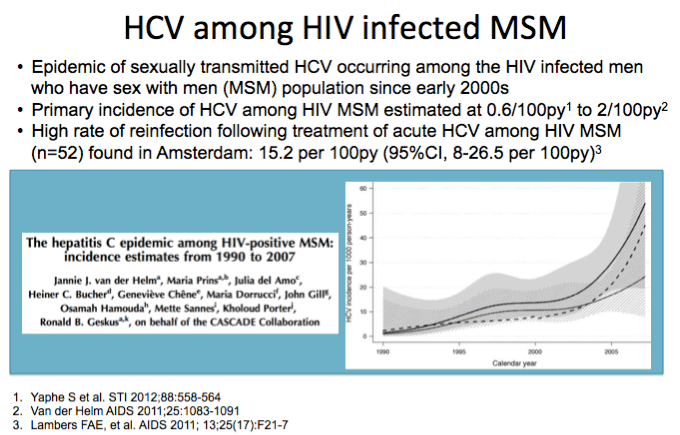
Unfortunately, since the early 2000s we have also witnessed the emergence of an epidemic of sexually transmitted HCV among men who have sex with men associated with high-risk sexual practices, recreational drug use and ulcerating anal lesions. From the CASCADE study, shown here in the graph, you can see the upturn in HCV incidence since 2005 using three slightly different inclusion criteria. Using pooled cohort data and meta-analyses it is estimated that the primary infection incidence is in the range of 0.6-2/100py. Now, reinfection with HCV is possible and has been demonstrated among MSM. One study in Amsterdam reported HCV reinfection rates following treatment for HCV as high as 15.2/100py. The reinfection incidence elsewhere is unknown and globally, there have been no studies on HCV reinfection outcomes among coinfected MSM such as spontaneous clearance and treatment success rates.
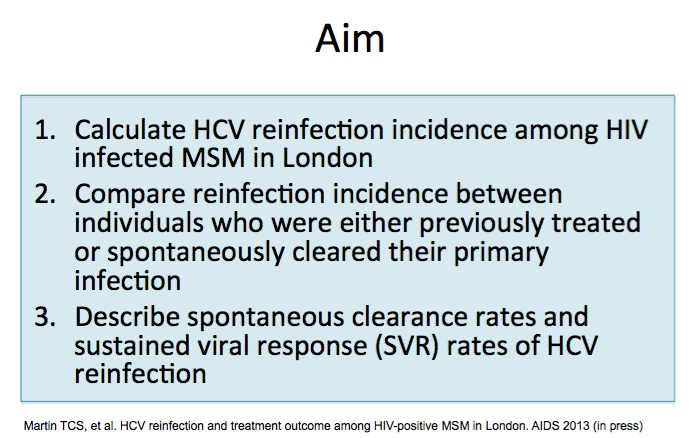
So the aim of our study therefore was to calculate the reinfection incidence among HIV positive MSM in London. We were also interested whether a difference in reinfection rate existed between individuals who had been treated for their HCV infection or who had spontaneously cleared their infection. Potential causes for a difference in reinfection rates could be the development of protective immunity among those who spontaneously clear the HCV virus leading to lower reinfection rates. Perhaps, however, going through the unpleasant course of interferon/ribavirin may alter future risk behaviours of patients treated for HCV virus leading THEM to have lower reinfection rates. Finally, we also wanted to describe infection outcomes of HCV reinfection - spontaneous clearance rates and treatment success rates.
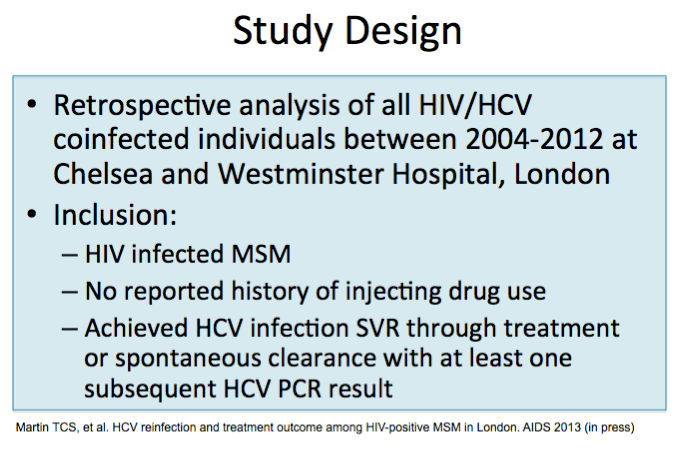
To do this, we conducted a retrospective analysis of all HIV/HCV coinfected individuals over the past 8 years. They were included if they were HIV positive MSM with no reported injecting drug use and had achieved HCV infection clearance either through treatment or through spontaneous clearance with at least one subsequent HCV PCR result for follow up.
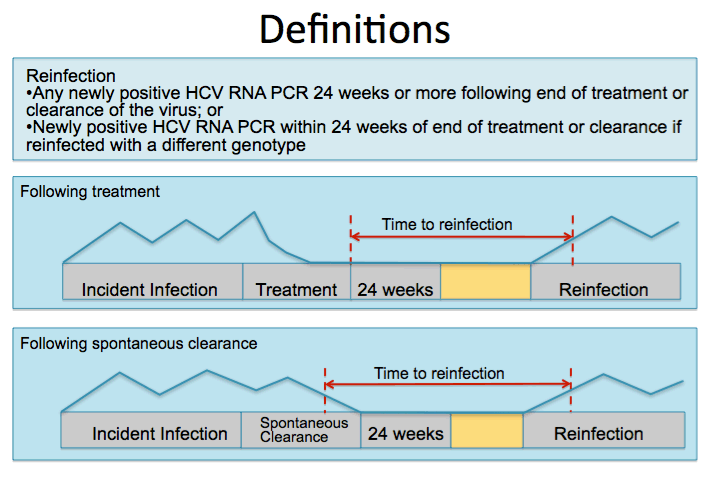
We defined reinfection as the emergence of any new viraemia 24 weeks or more following end of treatment or clearance of the virus OR the emergence of HCV viraemia within the 24 weeks required for sustained viral response but with a different genotype. Shown graphically here, you can see the progression through infection in boxed gray with a hypothetical HCV viral load represented by the blue line. We took the start of follow as the time when individuals became susceptible to reinfection: for treated patients, in the top diagram, this was the end of treatment; for spontaneous clearers, in the bottom diagram, this was taken as the mid-point between their last positive PCR and first negative. The time of reinfection was the same for both, taken as the mid-point between the last negative PCR and the first positive PCR.
A few of the group characteristics to draw your attention to. There were 191 patients in total representing 562 patient years follow up. Of these, 145 had negative HCV antibody in the year leading up to their incident infection, indicating their incident infection was their first infection - these 145 patients alone were used for the comparison of reinfection rates following treatment or spontaneous clearance of their first infection. Age was well matched across treated and spontaneously cleared groups and reinfected and non-reinfected groups. Also well matched were combination anti-retroviral therapy use and CD4 cell counts, both of which were generally high. Of note, testing interval during follow up was significantly longer among patients who had spontaneously cleared their first infection.
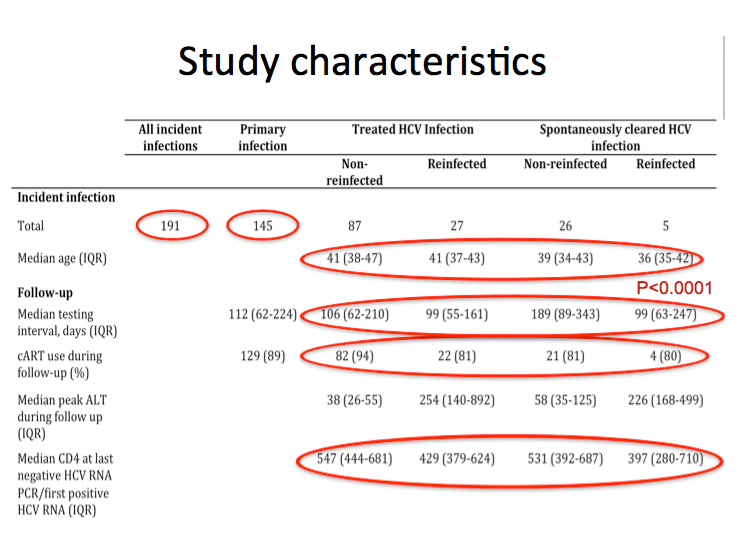
And here are our results. The overall reinfection rate among all 191 patients was 7.8/100py, which is approximately 5-10 times the primary infection incidence. Following treatment for HCV infection, the reinfection incidence was 9.6/100py compared to a reinfection incidence of 4.2/100py following spontaneous clearance. The difference between these two was non-significant with a p-value of 0.15. 17 patients who became reinfected reached SVR. Of these 17, 8 developed a second reinfection with the reinfection incidence shown on the right here - a highly concerning 23.2/100py.
This is a graphical representation of survival free from reinfection for patients previous treated for their HCV infection, shown in light gray, and individuals who spontaneously cleared their first HCV infection shown in dark gray. As you can see, there is a trend to a higher reinfection rate among individuals treated but this did not reach significance. One point to take from this graph is that, as you can see, approximately 25% of individuals treated for HCV infection were reinfected within just 2 years.
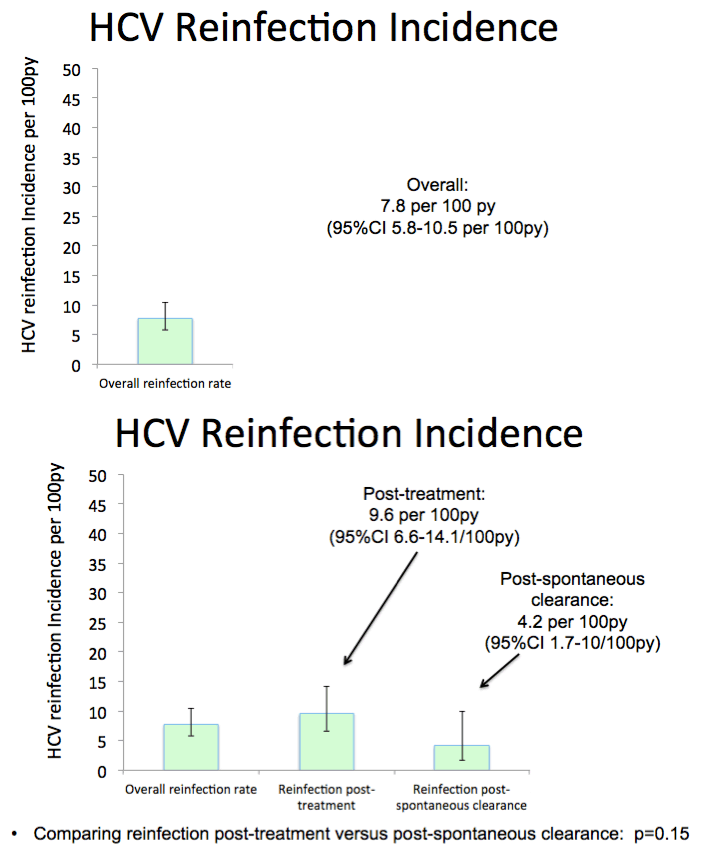
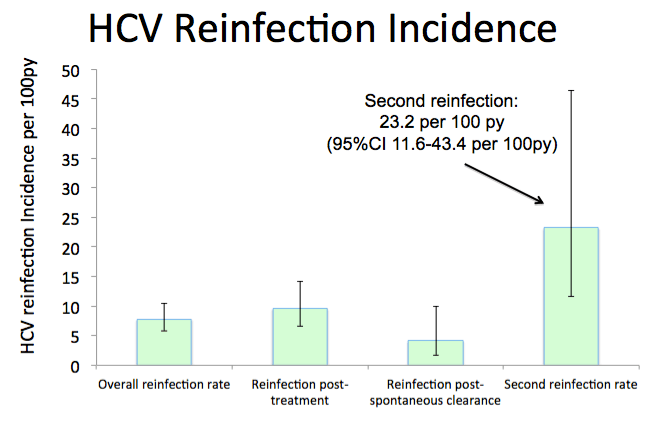
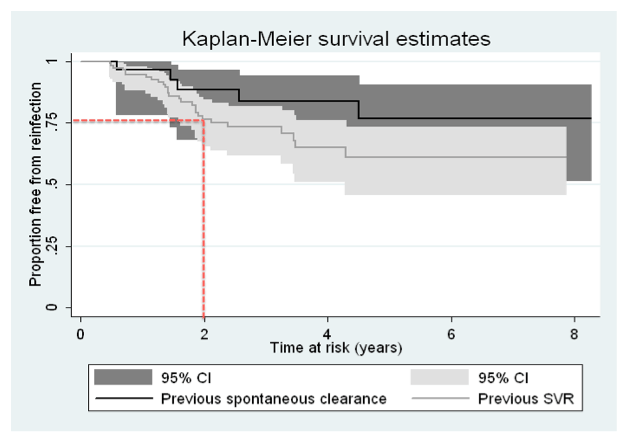
Including all reinfections - first, second and third there were 54 reinfections in total. 20% of reinfected individuals spontaneously cleared the virus, similar to spontaneous clearance rates reported in primary infection in HIV positive individuals. Treatment outcomes were also comparable to primary infection in HIV positive patients with 73% of genotype 1 and 4 reaching SVR and 100% of genotype 2+3 reaching SVR although, of course, the numbers were small. It's also worth noting that the vast majority of HCV reinfections were treated in the acute phase.
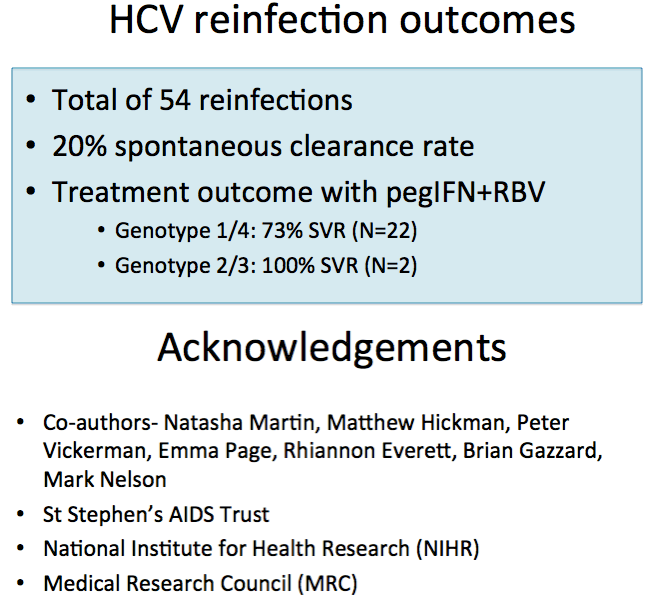
|
| |
|
 |
 |
|
|